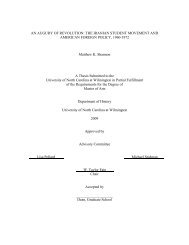HIERARCHAL INDUCTIVE PROCESS MODELING AND ANALYSIS ...
HIERARCHAL INDUCTIVE PROCESS MODELING AND ANALYSIS ...
HIERARCHAL INDUCTIVE PROCESS MODELING AND ANALYSIS ...
Create successful ePaper yourself
Turn your PDF publications into a flip-book with our unique Google optimized e-Paper software.
∴ a 23 = 4.5.10 −4 ≤ F (t) ≤ ∞ (29)<br />
As was the case for Nitrate, Iron is bounded below by Parameter 23.<br />
This<br />
concludes the analysis of Model B.<br />
Models A and B are the two good fit models under a .5 reMSE which came<br />
up the most frequently throughout the 31 experiments.<br />
Our analysis has shown<br />
that the structure of the equations for phytoplankton and detritus produce similar<br />
dynamics and bounds for both models; on the other hand where iron and nitrate<br />
were bounded above with a parameter in Model A they were bounded below by<br />
a parameter value in Model B . Also, the structure and bounds for zooplankton<br />
had much more variations. For instance, the bounds for Model A implied that the<br />
zooplankton population will go to extinction whereas bounds for Model B indicated<br />
that the population has an upper bound at the carrying capacity K. This simple<br />
observation led me to look more into the zooplankton dynamic, to do so I chose to<br />
select the model with the lowest reMSE from experiment 6. In this experiment HIPM<br />
was provided observations for both phytoplankton and zooplankton dynamics. This<br />
was not a random choice since phytoplankton is the dynamic we are trying to model<br />
and zooplankton is the state variable demonstrating the most variability in structure<br />
and having potentially the most restrictive power out of all state variables, based on<br />
computational results. This model will be presented as Model C.<br />
56
















